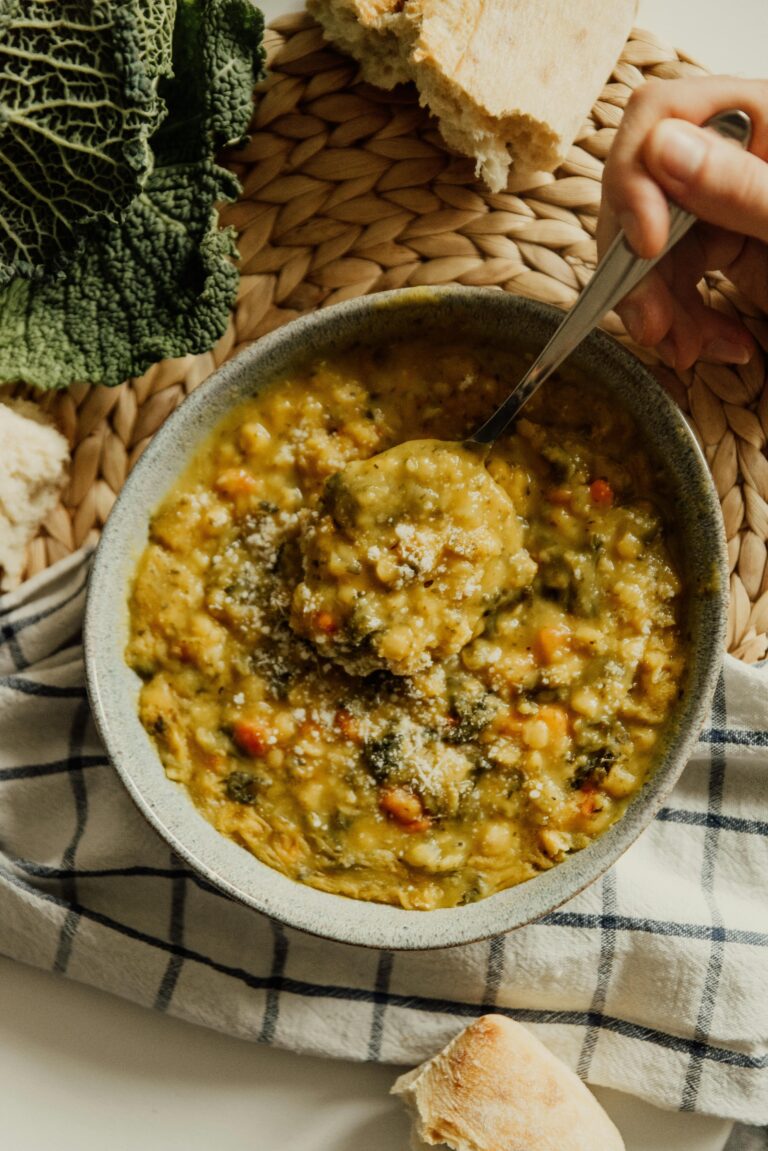La Ribollita alla Fiorentina: Tuscany’s Warmest Embrace in a Bowl 🥣🌿
Imagine a chilly Tuscan evening, the scent of rosemary lingering in the air, and a steaming bowl of Ribollita cradled in your hands. This isn’t just soup—it’s tradition, memory, and nourishment all simmered into one. La Ribollita alla Fiorentina is the kind of dish that wraps you in warmth, feeds your soul, and tells the story of Tuscany’s humble yet rich culinary heritage.
Rooted in cucina povera, this hearty vegetable and bread soup transforms simple, leftover ingredients into a deeply flavorful masterpiece. And true to its name—ribollita, meaning “reboiled”—it’s even better the next day, when the flavors have deepened and the texture becomes luxuriously thick.
🥬 What Is Ribollita?
Ribollita is a rustic Tuscan soup made from stale bread, cannellini beans, and seasonal vegetables like cavolo nero (Tuscan kale), cabbage, carrots, and potatoes. It’s slow-cooked to perfection, then reboiled the next day for an even richer taste. This dish is a celebration of resourcefulness, flavor, and the comforting power of slow food.
It’s not just a recipe—it’s a ritual. A dish born from frugality, elevated by time and tradition.
🍲 Ingredients: The Soul of the Soup
To prepare an authentic Ribollita alla Fiorentina, gather these wholesome ingredients:
- Stale Tuscan Bread – 300g (10.5 oz), unsalted and rustic, torn into hearty chunks
- Cavolo Nero (Tuscan Kale) – 300g (10.5 oz), washed and chopped
- Savoy Cabbage – 200g (7 oz), chopped for texture and sweetness
- Cannellini Beans – 300g dried (soaked and cooked) or 2 cans, drained and rinsed
- Carrots – 2, chopped for earthy sweetness
- Celery – 2 stalks, chopped for aromatic depth
- Onion – 1 large, chopped
- Garlic – 2–3 cloves, minced for bold flavor
- Potatoes – 2, peeled and chopped for creaminess
- Tomato Passata or Crushed Tomatoes – 400g (14 oz), for richness
- Vegetable Broth – 1.5 liters (6 cups), warm and savory
- Extra Virgin Olive Oil – 4 tablespoons, plus more for drizzling
- Salt & Black Pepper – To taste
- Fresh Thyme or Rosemary – Optional, for a fragrant Tuscan touch
- Grated Parmesan Cheese – Optional, for serving
👩🍳 How to Make Ribollita: Step-by-Step
1. Cook the Beans
If using dried beans, soak overnight, then simmer until tender (about 1–1.5 hours). Drain and set aside. For canned beans, simply rinse and drain.
2. Sauté the Base
In a large pot, heat olive oil over medium heat. Add onion, carrots, and celery. Sauté until soft and fragrant—this is your aromatic foundation.
Add garlic and cook for another minute, letting its bold aroma bloom.
3. Add Potatoes and Tomatoes
Stir in the potatoes and tomato passata. Let them mingle and simmer for a few minutes, building depth and richness.
4. Add Greens and Beans
Add chopped cavolo nero and cabbage. Stir well. Add the cooked beans and pour in the vegetable broth. Toss in thyme or rosemary if using.
Season generously with salt and pepper.
5. Simmer Slowly
Bring to a gentle boil, then reduce heat and let it simmer for about 1 hour. The vegetables should be tender, the broth infused with flavor.
6. Add the Bread
Add chunks of stale bread and stir. Let them soak, soften, and thicken the soup into a rich, stew-like consistency. Simmer for another 10–15 minutes.
7. Reboil for Magic (Optional but Authentic)
Let the soup cool and refrigerate overnight. Reheat gently the next day—this “reboiling” intensifies the flavors and gives ribollita its signature texture.
🌟 Serving Suggestions
Serve Ribollita piping hot, drizzled with extra virgin olive oil and topped with grated Parmesan if desired. Pair it with a glass of robust Chianti and a slice of Tuscan bread for the full experience.
💡 Tips for the Perfect Ribollita
- Choose Quality Ingredients: Fresh vegetables and good olive oil make all the difference.
- Use Real Stale Bread: It’s essential for texture. Dry fresh bread in the oven if needed.
- Simmer Slowly: Let the flavors meld—this soup rewards patience.
- Reboil for Depth: The second day is when ribollita truly shines.
📚 Cultural Significance
- Cucina Povera: A shining example of Italy’s peasant cuisine, where nothing goes to waste and everything is made with love.
- Seasonal Comfort: Traditionally enjoyed in autumn and winter, ribollita warms both body and spirit.
- Historical Roots: Born from reheated leftovers, this dish reflects the ingenuity of Tuscan home cooks across generations.
❤️ Why Ribollita Captures the Heart
Because it’s more than soup—it’s a story. A tale of Tuscan resilience, of flavors deepened by time, and of meals shared around rustic wooden tables. La Ribollita alla Fiorentina is comfort, culture, and cuisine in one unforgettable bowl.

